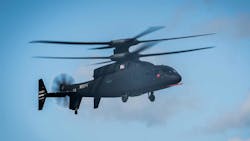Vertical-lift future aircraft for Black Hawk replacement enters new development phase; downselect next year
REDSTONE ARSENAL, Ala. – The U.S. Army is starting the second and final development phase of the Future Long-Range Assault Aircraft (FLRAA) before downselecting to one contractor sometime next year to build vertical-lift prototypes of the replacement for the Sikorsky UH-60 Black Hawk utility helicopter.
Officials of the Army Contracting Command at Redstone Arsenal awarded two contracts -- one to Bell Textron Inc. in Fort Worth, Texas, and the other to Sikorsky Aircraft, a Lockheed Martin company in Stratford, Conn. for the FLRAA Competitive Demonstration and Risk Reduction Phase 2 project.
Army leaders want to start fielding the FLRAA as a Black Hawk replacement by 2030. The project's second phase will help determine if the FLRAA will be suitable for Special Forces uses, for medical evacuation, and if the design could be exportable.
At the same Time, Army experts are working with Bell and Sikorsky to start integrating the FLRAA's major subsystems and the candidate weapons systems. Bell won a $292.6 million order and Sikorsky won a $284.4 million order on 30 March to begin the FLRAA's second phase.
The Army also has a contract solicitation out to find ways to develop open-systems enabling technologies to manage aircraft crew member cognitive workload, as part of the Revolutionary Technology and Strategies for the Holistic Situational Awareness—Decision Making (HSA-DM) program.
The technologies developed from this future aircraft program potentially are for integration into avionics for the FLRAA and the Future Attack Reconnaissance Aircraft (FARA). Suggested technologies must conform to the Modular Open Systems Approach (MOSA) and Future Airborne Capability Environment (FACE) industry standards.
This program could develop avionics technologies for the FLRAA to include synthetic vision for operating in dust or snow; vertical-lift integrated mission equipment; a joint common avionics architecture; route optimization; survivability against networked threats; piloted and unmanned aircraft teaming; command and control; multi-role mission systems; and advanced teaming.
This project to develop advanced avionics for the FLRAA and other future Army aircraft has four separate efforts: information management; data and sensor fusion; autonomous decision aiding and information distillation; and human-machine interfaces.
Information management seeks to identify information management technologies to receive, process, store, and transmit terabytes of data and knowledge products from several sources simultaneously.
Data and sensor fusion seeks to identify technologies to accept data from several sensors, databases, and networks, and fuse the data into a comprehensive “own-ship” world model or information manager.
Autonomous decision aiding and information distillation seeks to identify technologies capable of distilling data and information into knowledge products for crew member adjudication and/or autonomous decision making.
Human machine interfaces seeks to identify technologies that facilitate intuitive communication of operational knowledge to and from aircraft crew members.
The types of avionics systems that could be part of this program -- and by extension part of the FLRAA -- include communications; aircraft status; navigation; augmented flight control; weapons; crew systems; and fused sensor data. Proposed technologies meet standards for cyber security and information assurance.
On these orders Bell will do the work in Fort Worth, Texas; Owego, N.Y.; Wichita, Kan.; Torrance and Garden Grove, Calif.; Jackson and Grand Rapids, Mich.; Indianapolis; Cary, N.C.; Kirkland, Wash.; Tallassee, Ala,; Lod, Israel; Papendrecht, Netherlands; and Ajax, Ontario, and should be finished by March, 2022.
Sikorsky, meanwhile, will do the work in Ridley Park, Coatesville, and King of Prussia, Pa.; Stratford, Conn.; Owego, N.Y.; Fort Worth, Texas; and Jupiter, and Orlando, Fla., and should be finished by May 2022.
For more information contact Bell Textron online at www.textron.com/About/Our-Businesses/Bell, Sikorsky at www.lockheedmartin.com/en-us/capabilities/sikorsky.html, or the Army Contracting Command at www.army.mil/acc.
About the Author
John Keller
Editor-in-Chief
John Keller is the Editor-in-Chief, Military & Aerospace Electronics Magazine--provides extensive coverage and analysis of enabling electronics and optoelectronic technologies in military, space and commercial aviation applications. John has been a member of the Military & Aerospace Electronics staff since 1989 and chief editor since 1995.
